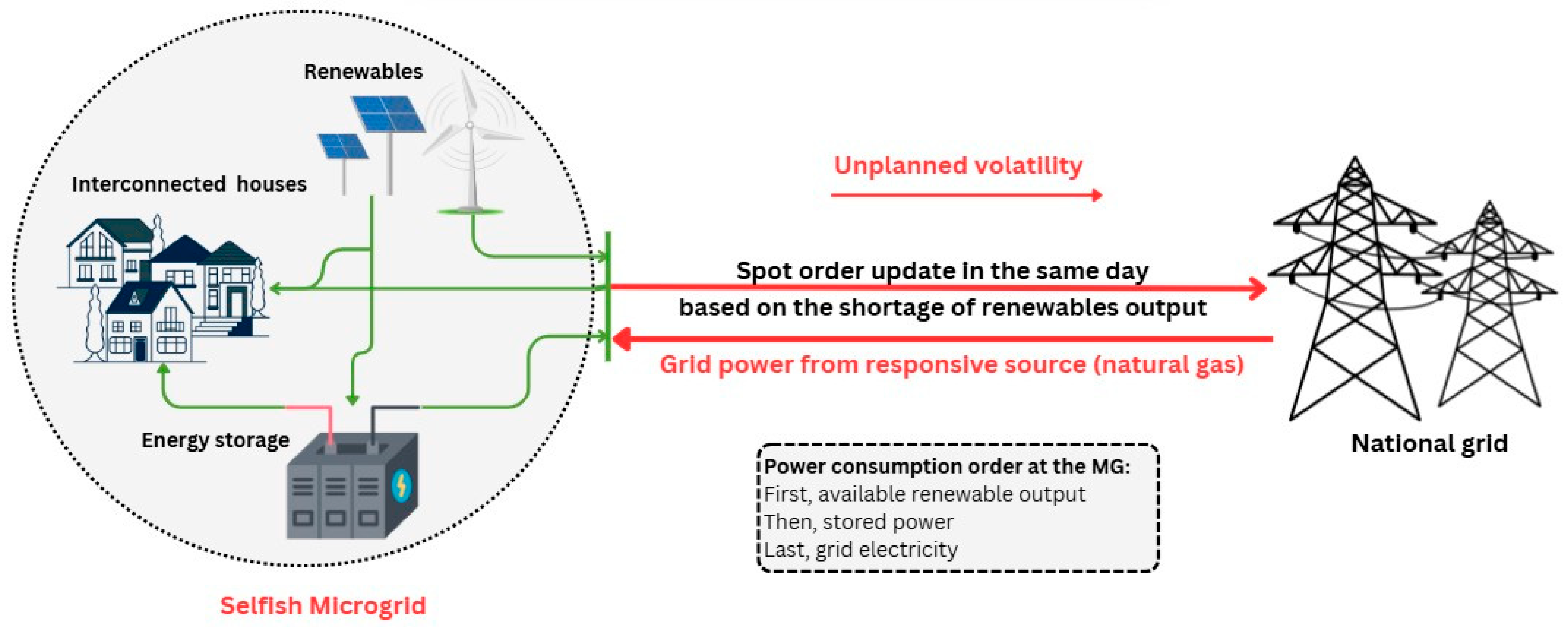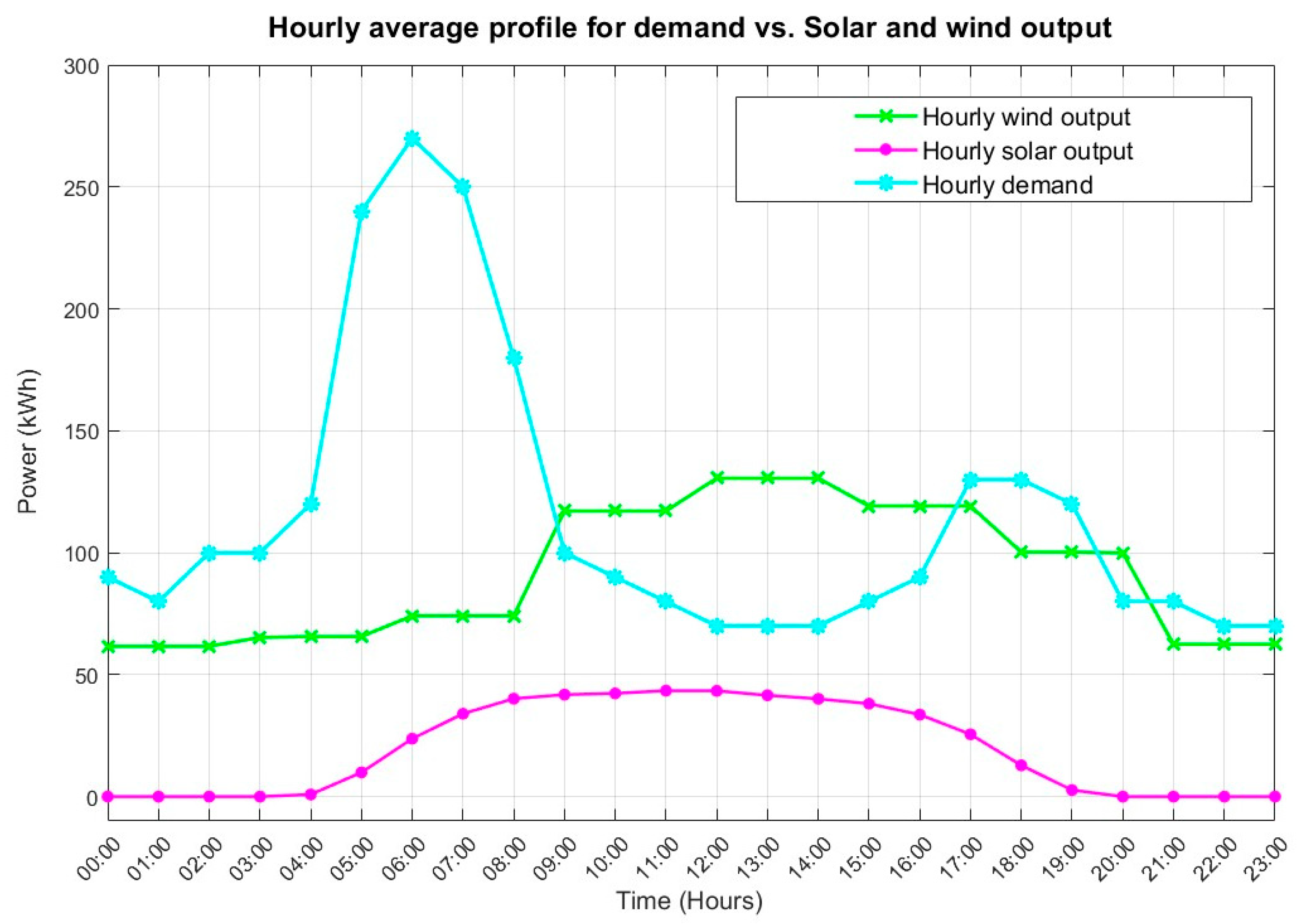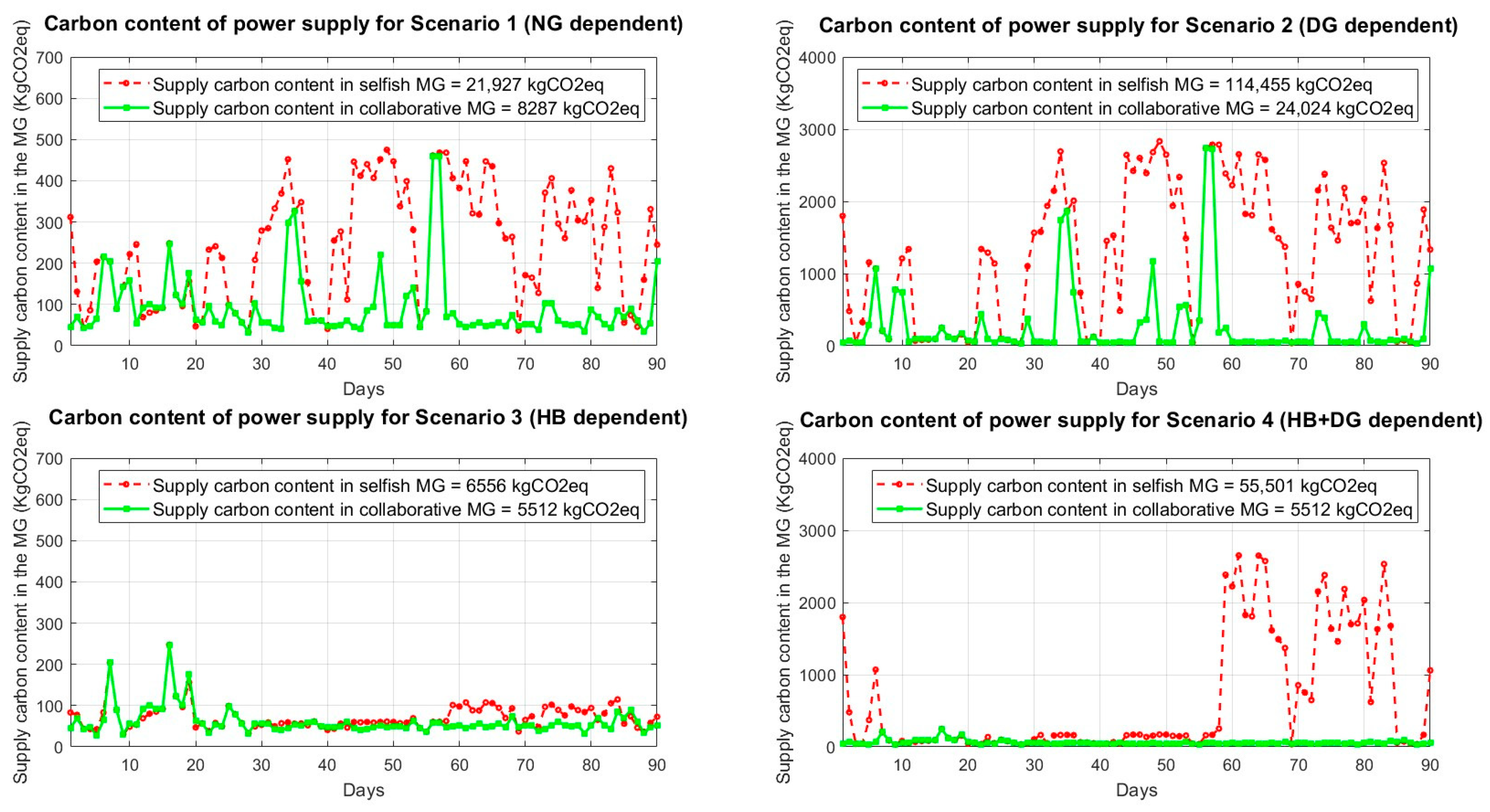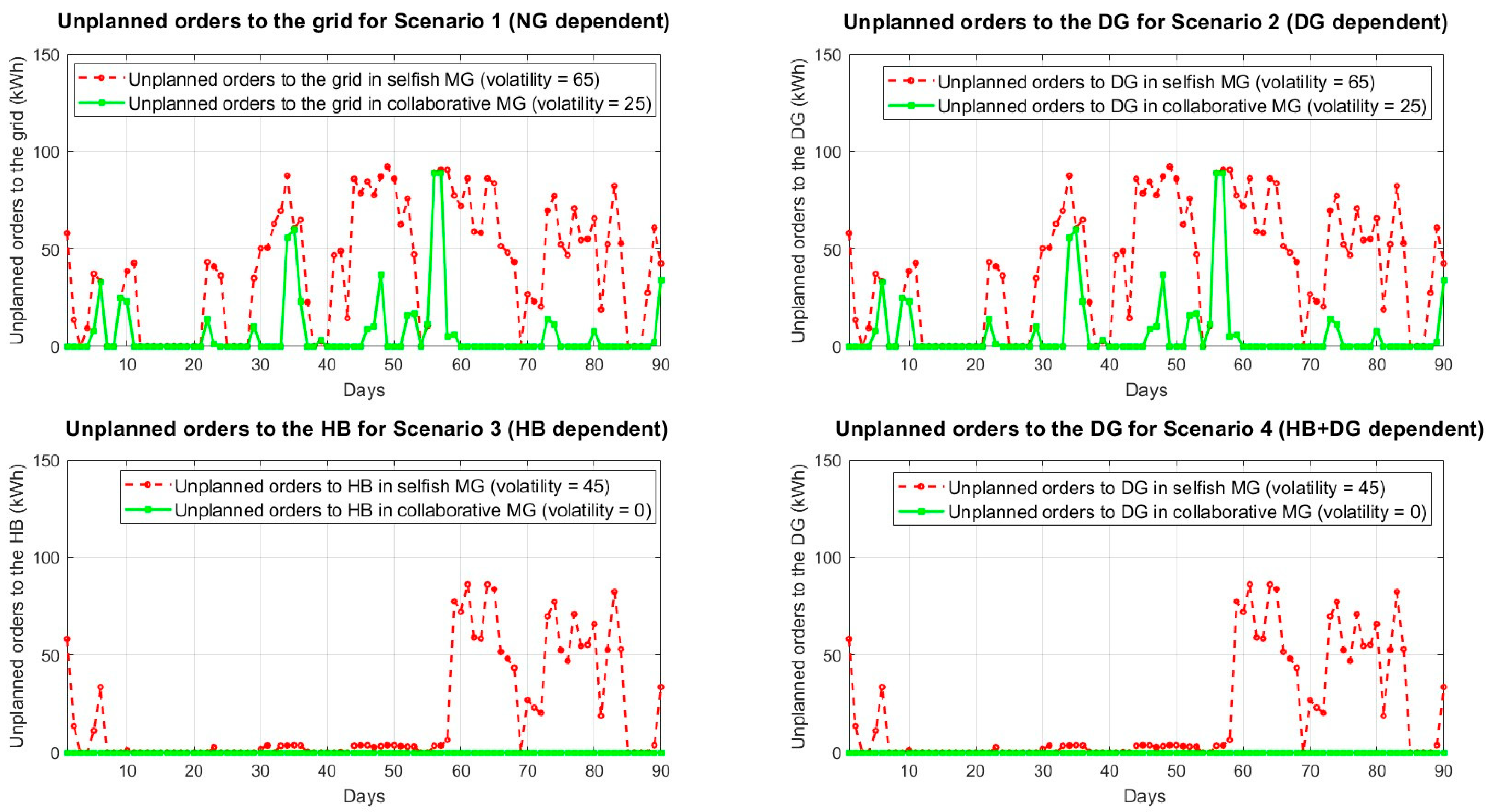Shifting Towards Greener and More Collaborative Microgrids by Applying Lean-Heijunka Strategy
Abstract
:1. Introduction
2. Literature Review
3. Method
3.1. COU Strategy Description
3.2. Models and Scenarios
Power Flows in the Studied Scenarios
3.3. Modelling of Power Demand
3.4. Modelling of Basic Power Supply from Renewables
3.4.1. Wind Power and Solar Power
- Wind power:
- Solar power:
3.4.2. Power in Basic Storage
3.5. Modelling of Backup Generation Options
3.5.1. National Grid
3.5.2. Diesel Generator
3.5.3. Hydrogen Burner
Power in Additional Storage
3.5.4. Hydrogen Burner and Diesel Generator
3.6. Performance Measures
3.6.1. Supply Carbon Content
3.6.2. Unplanned Orders and Its Volatility
3.6.3. Exported Power to the Grid
4. Results
4.1. Models’ Parameters
4.2. Supply Carbon Content
4.3. Unplanned Orders and Its Volatility
4.4. Exported Power to the Grid
5. Discussion
Author Contributions
Funding
Data Availability Statement
Conflicts of Interest
Abbreviations
| MG | Microgrid |
| T | Time (The UK standard time) |
| D(t) | The aggregate demand for the interconnected households at time t |
| d(t) | The power demand for each household |
| Nh | The total number of households |
| S(t) | The power supply from wind turbine and PV panels at time t |
| Ppv(t) | The theoretical power output from PV at time t |
| Pw(t) | The power output from wind turbine at time t, kilowatts |
| Cp | Maximum power coefficient (theoretical maximum = 0.59) |
| Ρ | Air density, 0.08 lb/ft3 |
| A | Rotor swept area, ft2 |
| V(t) | Wind speed at time t, mph |
| K | 0.000133, a constant to yield power in kilowatts. |
| I(t) | The irradiance at time t, Wh/m2 |
| A | The total panel area (area of one panel *Np) |
| η | Nominal efficiency for the panel |
| Pst(t) | The power in storage system at time t, kilowatts |
| COU(t) | Precontracted grid order update at time t |
| Pst (t − 1) | The power in storage system at the previous hour, kilowatts |
| S(t) | The power supply from wind turbine and PV panels at time t |
| Stc | Storage capacity, kilowatts |
| Ste | Storage system efficiency |
| PDGAHB(t) | Power from diesel generator after power from H2 burner at time t, kilowatts |
| PHB(t) | Power from H2 burner at time t, kilowatts |
| PDG(t) | Power from diesel generator at time t, kilowatts |
| PHB-AS(t) | Power from H2 burner based on additional storage at time t, kilowatts |
| PHB-HS(t) | Power from H2 burner based on H2 supply at time t, kilowatts |
| PAS(t) | Power in the additional storage at time t, kilowatts |
| N | Number of hours within the modelled time horizon (T) |
| Pexp(t) | The exported power to the grid at each hour. |
| TPexp | The total exported power to the grid within a time horizon. |
| VSOU | The volatility of spot order updates |
| The mean of spot order updates | |
| Scc | Total carbon content of supply from different sources, kgCO2eq |
| Ty | Total power supply from all sources to the MG, kWh |
| ei | Emission factor for each source, kgCO2eq/kWh |
| yi(t) | Supply from each source at time t, kWh |
References
- Gudde, P.; Oakes, J.; Cochrane, P.; Caldwell, N.; Bury, N. The Role of UK Local Government in Delivering on Net Zero Carbon Commitments: You’ve Declared a Climate Emergency, so What’s the Plan? Energy Policy 2021, 154, 112245. [Google Scholar] [CrossRef]
- Che, E.E.; Abeng, K.R.; Iweh, C.D.; Tsekouras, G.J.; Fopah-Lele, A. The Impact of Integrating Variable Renewable Energy Sources into Grid-Connected Power Systems: Challenges, Mitigation Strategies, and Prospects. Energies 2025, 18, 689. [Google Scholar] [CrossRef]
- Sato, T.; Murata, K.; Katayama, H. On Stability of Supply Performance by Work-in-Progress Management: A Case Analysis of Photovoltaics-Based Electricity Supply System with Storage Batteries. Procedia Manuf. 2017, 11, 1077–1084. [Google Scholar] [CrossRef]
- Feleafel, H.; Radulovic, J.; Leseure, M. Should We Have Selfish Microgrids? Energies 2024, 17, 3969. [Google Scholar] [CrossRef]
- Shahzad, S.; Jasińska, E. Renewable Revolution: A Review of Strategic Flexibility in Future Power Systems. Sustainability 2024, 16, 5454. [Google Scholar] [CrossRef]
- Danley, D.R. Defining a Microgrid Using IEEE 2030.7. In Business & Technology; National Rural Electric Cooperative Association: Arlington, VA, USA, 2019. [Google Scholar]
- Yakimenko, O.A. Efficiency, Reliability, and Resilience of Diesel Generator Based Isolated Microgrids. In Proceedings of the 2024 IEEE 18th International Conference on Control & Automation (ICCA) 2024, Reykjavík, Iceland, 18–21 June 2024; pp. 288–293. [Google Scholar] [CrossRef]
- Belboul, Z.; Toual, B.; Bensalem, A.; Ghenai, C.; Khan, B.; Kamel, S. Techno-Economic Optimization for Isolated Hybrid PV/Wind/Battery/Diesel Generator Microgrid Using Improved Salp Swarm Algorithm. Sci. Rep. 2024, 14, 2920. [Google Scholar] [CrossRef]
- Tariq, A.H.; Kazmi, S.A.A.; Hassan, M.; Ali, M.S.; Anwar, M. Analysis of Fuel Cell Integration with Hybrid Microgrid Systems for Clean Energy: A Comparative Review. Int. J. Hydrogen Energy 2023, 52, 1005–1034. [Google Scholar] [CrossRef]
- Mewafy, A.; Ismael, I.; Kaddah, S.S.; Hu, W.; Chen, Z.; Abulanwar, S. Optimal Design of Multiuse Hybrid Microgrids Power by Green Hydrogen–Ammonia. Renew. Sustain. Energy Rev. 2023, 192, 114174. [Google Scholar] [CrossRef]
- Jafarizadeh, H.; Yamini, E.; Zolfaghari, S.M.; Esmaeilion, F.; Assad, M.E.H.; Soltani, M. Navigating Challenges in Large-Scale Renewable Energy Storage: Barriers, Solutions, and Innovations. Energy Rep. 2024, 12, 2179–2192. [Google Scholar] [CrossRef]
- Levina, A.; Davydova, O.; Kalyazina, S. No “One-Size-Fits-All” Solution for Energy Transition: Five Countries Scenario Analysis. World-Syst. Evol. Glob. Futures 2024, 2 Pt F3951, 65–88. [Google Scholar] [CrossRef]
- Venizelou, V.; Poullikkas, A. Trend Analysis of Cross-Border Electricity Trading in Pan-European Network. Energies 2024, 17, 5318. [Google Scholar] [CrossRef]
- Ma, N.; Zhao, W.; Wang, W.; Li, X.; Zhou, H. Large Scale of Green Hydrogen Storage: Opportunities and Challenges. Int. J. Hydrogen Energy 2023, 50, 379–396. [Google Scholar] [CrossRef]
- Constantin, A. Nuclear Hydrogen Projects to Support Clean Energy Transition: Updates on International Initiatives and IAEA Activities. Int. J. Hydrogen Energy 2024, 54, 768–779. [Google Scholar] [CrossRef]
- Europe’s Largest Battery Creates a Buzz in Bedfordshire-Power Technology. Available online: https://www.power-technology.com/features/featureeuropes-largest-battery-creates-a-buzz-in-bedfordshire-4563310/ (accessed on 25 February 2025).
- Babayomi, O.O.; Olubayo, B.; Denwigwe, I.H.; Somefun, T.E.; Adedoja, O.S.; Somefun, C.T.; Olukayode, K.; Attah, A. A Review of Renewable Off-Grid Mini-Grids in Sub-Saharan Africa. Front. Energy Res. 2023, 10, 1089025. [Google Scholar] [CrossRef]
- Pappas, D.; Braunholtz-Speight, T.; Hannon, M.; Webb, J.; González, F.F.; Sharmina, M. Business Models for Smart Local Energy Systems—A Triple Layered Perspective. Front. Sustain. Energy Policy 2023, 1, 1058534. [Google Scholar] [CrossRef]
- Nikmehr, N.; Najafi-Ravadanegh, S. Optimal Operation of Distributed Generations in Micro-Grids under Uncertainties in Load and Renewable Power Generation Using Heuristic Algorithm. IET Renew. Power Gener. 2015, 9, 982–990. [Google Scholar] [CrossRef]
- Ma, G.; Li, J.; Zhang, X.P. Energy Storage Capacity Optimization for Improving the Autonomy of Grid-Connected Microgrid. IEEE Trans. Smart Grid 2023, 14, 2921–2933. [Google Scholar] [CrossRef]
- Abdulkarim, A.; Gladwin, D.T. A Sensitivity Analysis on Power to Energy Ratios for Energy Storage Systems Providing Both Dynamic Firm and Dynamic Containment Frequency Response Services in the UK. In Proceedings of the IECON 2021–47th Annual Conference of the IEEE Industrial Electronics Society, Toronto, ON, Canada, 13–16 October 2021. [Google Scholar] [CrossRef]
- Feleafel, H.; Leseure, M. Feed-in Tariff Policy for Microgrids: Past and Future a Case Study of the Option Value of Complementary Energy Assets in Turbulent Conditions. Int. J. Energy Sect. Manag. 2025. ahead-of-print. [Google Scholar] [CrossRef]
- Manandhar, U.; Zhang, X.; Beng, G.H.; Subramanian, L.; Lu, H.H.C.; Fernando, T. Enhanced Energy Management System for Isolated Microgrid with Diesel Generators, Renewable Generation, and Energy Storages. Appl. Energy 2023, 350, 121624. [Google Scholar] [CrossRef]
- Martinez-Bolanos, J.R.; Manito, A.R.A.; Almeida, M.P.; Almeida, J.C.; Torres, P.F.; Pinho, J.T.; Zilles, R. Improved Dynamic Model of Small Stand-Alone Diesel Generators to Assess the Stability of Autonomous Microgrids. AIP Adv. 2025, 15, 25118. [Google Scholar] [CrossRef]
- Singh, B.; Pathak, G.; Panigrahi, B.K. Seamless Transfer of Renewable-Based Microgrid Between Utility Grid and Diesel Generator. IEEE Trans. Power Electron. 2017, 33, 8427–8437. [Google Scholar] [CrossRef]
- Sanni, S.O.; Oricha, J.Y.; Oyewole, T.O.; Bawonda, F.I. Analysis of Backup Power Supply for Unreliable Grid Using Hybrid Solar PV/Diesel/Biogas System. Energy 2021, 227, 120506. [Google Scholar] [CrossRef]
- Cavalcanti, M.H.C.; Pappalardo, J.R.; Barbosa, L.T.; Brasileiro, P.P.F.; Roque, B.A.C.; Silva, N.M.P. da R. Hydrogen in Burners: Economic and Environmental Implications. Processes 2024, 12, 2434. [Google Scholar]
- Faraji, J.; Babaei, M.; Bayati, N.; Hejazi, M.A. A Comparative Study between Traditional Backup Generator Systems and Renewable Energy Based Microgrids for Power Resilience Enhancement of a Local Clinic. Electronics 2019, 8, 1485. [Google Scholar] [CrossRef]
- Mutluri, R.B.; Saxena, D.; Sumitkumar, R. Knowledge-Based Coordinated Management of Hydrogen-Based Networked Microgrids with Hydrogen Vehicle Fueling Station. In Proceedings of the 2024 IEEE 4th International Conference on Sustainable Energy and Future Electric Transportation, SEFET, Hyderabad, India, 31 July–3 August 2024. [Google Scholar] [CrossRef]
- Salih, S.M.; Taha, M.Q.; Alawsaj, M.K. Performance Analysis of Wind Turbine Systems under Different Parameters Effect INTERNATIONAL JOURNAL OF ENERGY AND ENVIRONMENT Performance Analysis of Wind Turbine Systems under Different Parameters Effect. Int. J. Energy Environ. 2012, 3, 895–904. [Google Scholar]
- How To Calculate Power Output Of Wind | Windpower Engineering. Available online: https://www.windpowerengineering.com/calculate-wind-power-output/ (accessed on 6 August 2024).
- BONUS 450-B600/37-Wind Turbines Sale • MWPS Wind Turbines. Available online: https://www.mwps.co.uk/product/used-wind-turbines-offered/175kw-500kw-wind-turbines/bonus-450-wind-turbines-sale/ (accessed on 30 July 2024).
- Yano, A.; Furue, A.; Kadowaki, M.; Tanaka, T.; Hiraki, E.; Miyamoto, M.; Ishizu, F.; Noda, S. Electrical Energy Generated by Photovoltaic Modules Mounted inside the Roof of a North–South Oriented Greenhouse. Biosyst. Eng. 2009, 103, 228–238. [Google Scholar] [CrossRef]
- 320 Watt Monocrystalline Solar Panel | Renogy Solar. Available online: https://www.renogy.com/320-watt-monocrystalline-solar-panel/ (accessed on 22 July 2024).
- Wind, Waves & Weather Forecast Southampton Port-Windfinder. Available online: https://www.windfinder.com/forecast/southampton_port (accessed on 17 April 2022).
- Global Solar Atlas. Available online: https://globalsolaratlas.info/map?c=11.523088,8.173828,3 (accessed on 3 October 2024).
- Akyüz, E.S.; Telli, E.; Farsak, M. Hydrogen Generation Electrolyzers: Paving the Way for Sustainable Energy. Int. J. Hydrogen Energy 2024, 81, 1338–1362. [Google Scholar] [CrossRef]
- What Is the Carbon Footprint of Solar Panels? | Solar.Com. Available online: https://www.solar.com/learn/what-is-the-carbon-footprint-of-solar-panels/ (accessed on 6 October 2024).
- Thomson, C.; Harrison, G.P. Life Cycle Costs and Carbon Emissions of Wind Power Executive Summary; ClimateXChange: Edinburgh, Scotland, 2023. [Google Scholar]
- Carbon Dioxide Emissions From Electricity-World Nuclear Association. Available online: https://world-nuclear.org/information-library/energy-and-the-environment/carbon-dioxide-emissions-from-electricity (accessed on 6 October 2024).
- National Grid Carbon Intensity Archive-Electricity Info. Available online: https://electricityinfo.org/carbon-intensity-archive/#data (accessed on 6 October 2024).
- New 2024 UK Grid Emissions Factors-ITPEnergised. Available online: https://www.itpenergised.com/new-2024-uk-grid-emissions-factors/ (accessed on 6 October 2024).
- Akbari, E.; Naghibi, A.F.; Veisi, M.; Shahparnia, A.; Pirouzi, S. Multi-Objective Economic Operation of Smart Distribution Network with Renewable-Flexible Virtual Power Plants Considering Voltage Security Index. Sci. Rep. 2024, 14, 19136. [Google Scholar] [CrossRef]














| Study Ref. | Year | Microgrid Type | Backup Generation Solution | Impact on the Utility Grid |
|---|---|---|---|---|
| [3] | 2017 | Hybrid | Utility grid | Level demand, significant excess power |
| [25] | 2017 | Hybrid | Diesel and utility grid | Volatile demand |
| [28] | 2019 | Hybrid/Isolated | Utility grid/traditional generator | Stable demand, high sales to grid |
| [26] | 2021 | Hybrid | Diesel, biogas generator and utility grid | Volatile demand |
| [23] | 2023 | Isolated | Diesel generator | Unload the utility grid |
| [29] | 2024 | Interconnected MGs | Diesel, fuel cell, H2 and utility grid | Volatile demand |
| [22] | 2025 | Hybrid | Fuel cell, H2 and national grid | Volatile demand |
| [24] | 2025 | Isolated | Diesel generator | Unload the utility grid |
| Comparison Metric | Selfish MG | Collaborative MG |
|---|---|---|
| Order update to the grid | Traditional order update to the grid | The order update, called pre-contracted order update (COU) in this paper |
| Characteristics of the orders to grid | Spot orders in a sporadic fashion and no actual written order | Written and forward orders (one week ahead) |
| Reliance on utility grid | Avoid relying on utility grid as much as possible | Commitment to purchase electricity from the utility grid |
| Effect of orders on power demand | Increase in power demanded (the update is instantaneous) | Increase in power demanded (planned demand) |
| Who responsible for handling the demand and doing the forecast? | Electricity retailers, distributors, and suppliers | The MG itself responsible for the forecast |
| How the demand is handled? | Through the use of forecasts that are the backbone of the balancing system at the utility grid level | Local forecast takes into account planned demand but also a weather (intermittence) forecast at the MG level. |
| Forecast feasibility | More difficult to forecast than normal electricity demand | Easier forecast because it is at small scall (MG level) |
| Effect on the utility grid | More likely to be associated with fault currents or other exceptions that endanger the safe operation of the grid. | There may be instances when forecast errors necessitate an emergency spot order; but, the frequency of such orders will be significantly reduced |
| Potential Uncertainties (Forecast Errors and Demand Fluctuations) | Selfish MG (Current Energy Management) | Collaborative MG (COU Strategy) |
|---|---|---|
| The expected demand is lower than the reality | Affected by the uncertainty related to the forecast and demand but the mitigation strategy is at the utility grid level | Affected by the uncertainty related to the forecast and demand but the mitigation strategy is at the MG grid level. The COU level in that case will be lower than required; the MG can rely on its stored energy, buy additional hydrogen if the storage is empty, or it can use grid electricity (as other MG or end node would do) as a last resort action. |
| The expected demand is higher than the reality | Affected by the uncertainty related to the forecast and demand but the mitigation strategy is at the utility grid level | Affected by the uncertainty related to the forecast and demand but the mitigation strategy is at the MG grid level. The COU level in that case will be higher than required; excess energy can be stored in the 2-level storage described in the paper |
| Number of Wind Turbines | Number of PV Panels | Number of Households |
|---|---|---|
| 1 turbine | 380 panels | 70 |
| Max Output | Rotor Diameter | Hub Height |
|---|---|---|
| 450 kW | 37 m | 35 m |
| Max Output | Nominal Efficiency | Width | Height |
|---|---|---|---|
| 320 W | 21% | 1.666 m | 1.000 m |
| Power Source | Emission Factor (kgCO2eq/kWh) |
| Solar | 0.041 [38] |
| Wind | 0.012 [39] |
| Nuclear (COU) | 0.012 [40] |
| National grid (SOU) | 0.205 [41] |
| Diesel generator | 1.27 [42] |
| Time Horizon | Basic Storage Capacity | Basic Storage Efficiency | Additional Storage Efficiency |
|---|---|---|---|
| 90 days in Spring | 1500 kWh | 100% | 60% |
Disclaimer/Publisher’s Note: The statements, opinions and data contained in all publications are solely those of the individual author(s) and contributor(s) and not of MDPI and/or the editor(s). MDPI and/or the editor(s) disclaim responsibility for any injury to people or property resulting from any ideas, methods, instructions or products referred to in the content. |
© 2025 by the authors. Licensee MDPI, Basel, Switzerland. This article is an open access article distributed under the terms and conditions of the Creative Commons Attribution (CC BY) license (https://creativecommons.org/licenses/by/4.0/).
Share and Cite
Feleafel, H.; Leseure, M.; Radulovic, J. Shifting Towards Greener and More Collaborative Microgrids by Applying Lean-Heijunka Strategy. Eng 2025, 6, 69. https://doi.org/10.3390/eng6040069
Feleafel H, Leseure M, Radulovic J. Shifting Towards Greener and More Collaborative Microgrids by Applying Lean-Heijunka Strategy. Eng. 2025; 6(4):69. https://doi.org/10.3390/eng6040069
Chicago/Turabian StyleFeleafel, Hanaa, Michel Leseure, and Jovana Radulovic. 2025. "Shifting Towards Greener and More Collaborative Microgrids by Applying Lean-Heijunka Strategy" Eng 6, no. 4: 69. https://doi.org/10.3390/eng6040069
APA StyleFeleafel, H., Leseure, M., & Radulovic, J. (2025). Shifting Towards Greener and More Collaborative Microgrids by Applying Lean-Heijunka Strategy. Eng, 6(4), 69. https://doi.org/10.3390/eng6040069








